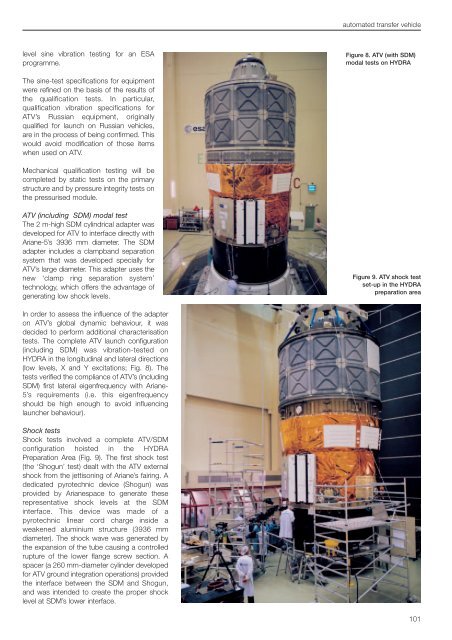Automated Transfer Vehicle (ATV) - ESA
Automated Transfer Vehicle (ATV) - ESA
Automated Transfer Vehicle (ATV) - ESA
Create successful ePaper yourself
Turn your PDF publications into a flip-book with our unique Google optimized e-Paper software.
level sine vibration testing for an <strong>ESA</strong><br />
programme.<br />
The sine-test specifications for equipment<br />
were refined on the basis of the results of<br />
the qualification tests. In particular,<br />
qualification vibration specifications for<br />
<strong>ATV</strong>’s Russian equipment, originally<br />
qualified for launch on Russian vehicles,<br />
are in the process of being confirmed. This<br />
would avoid modification of those items<br />
when used on <strong>ATV</strong>.<br />
Mechanical qualification testing will be<br />
completed by static tests on the primary<br />
structure and by pressure integrity tests on<br />
the pressurised module.<br />
<strong>ATV</strong> (including SDM) modal test<br />
The 2 m-high SDM cylindrical adapter was<br />
developed for <strong>ATV</strong> to interface directly with<br />
Ariane-5’s 3936 mm diameter. The SDM<br />
adapter includes a clampband separation<br />
system that was developed specially for<br />
<strong>ATV</strong>’s large diameter. This adapter uses the<br />
new ‘clamp ring separation system’<br />
technology, which offers the advantage of<br />
generating low shock levels.<br />
In order to assess the influence of the adapter<br />
on <strong>ATV</strong>’s global dynamic behaviour, it was<br />
decided to perform additional characterisation<br />
tests. The complete <strong>ATV</strong> launch configuration<br />
(including SDM) was vibration-tested on<br />
HYDRA in the longitudinal and lateral directions<br />
(low levels, X and Y excitations; Fig. 8). The<br />
tests verified the compliance of <strong>ATV</strong>’s (including<br />
SDM) first lateral eigenfrequency with Ariane-<br />
5’s requirements (i.e. this eigenfrequency<br />
should be high enough to avoid influencing<br />
launcher behaviour).<br />
Shock tests<br />
Shock tests involved a complete <strong>ATV</strong>/SDM<br />
configuration hoisted in the HYDRA<br />
Preparation Area (Fig. 9). The first shock test<br />
(the ‘Shogun’ test) dealt with the <strong>ATV</strong> external<br />
shock from the jettisoning of Ariane’s fairing. A<br />
dedicated pyrotechnic device (Shogun) was<br />
provided by Arianespace to generate these<br />
representative shock levels at the SDM<br />
interface. This device was made of a<br />
pyrotechnic linear cord charge inside a<br />
weakened aluminium structure (3936 mm<br />
diameter). The shock wave was generated by<br />
the expansion of the tube causing a controlled<br />
rupture of the lower flange screw section. A<br />
spacer (a 260 mm-diameter cylinder developed<br />
for <strong>ATV</strong> ground integration operations) provided<br />
the interface between the SDM and Shogun,<br />
and was intended to create the proper shock<br />
level at SDM’s lower interface.<br />
automated transfer vehicle<br />
Figure 8. <strong>ATV</strong> (with SDM)<br />
modal tests on HYDRA<br />
Figure 9. <strong>ATV</strong> shock test<br />
set-up in the HYDRA<br />
preparation area<br />
101

















